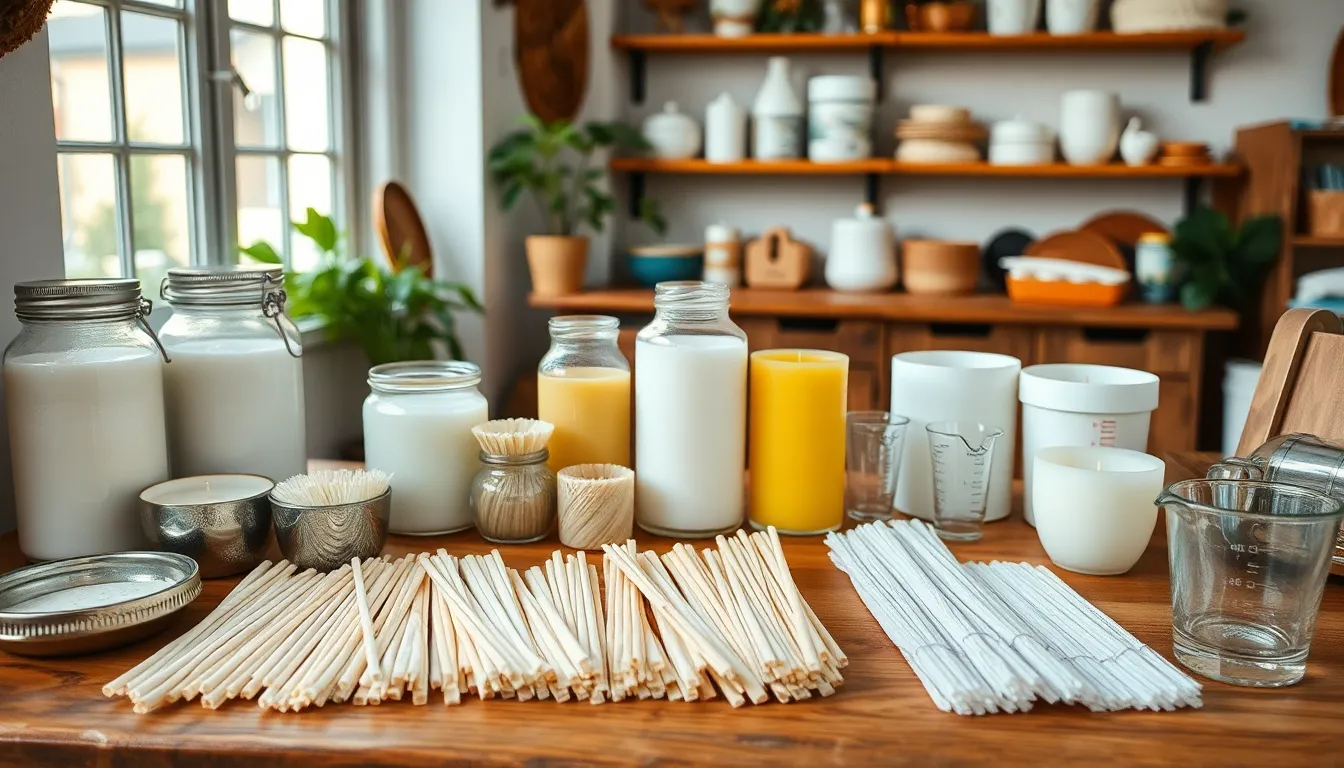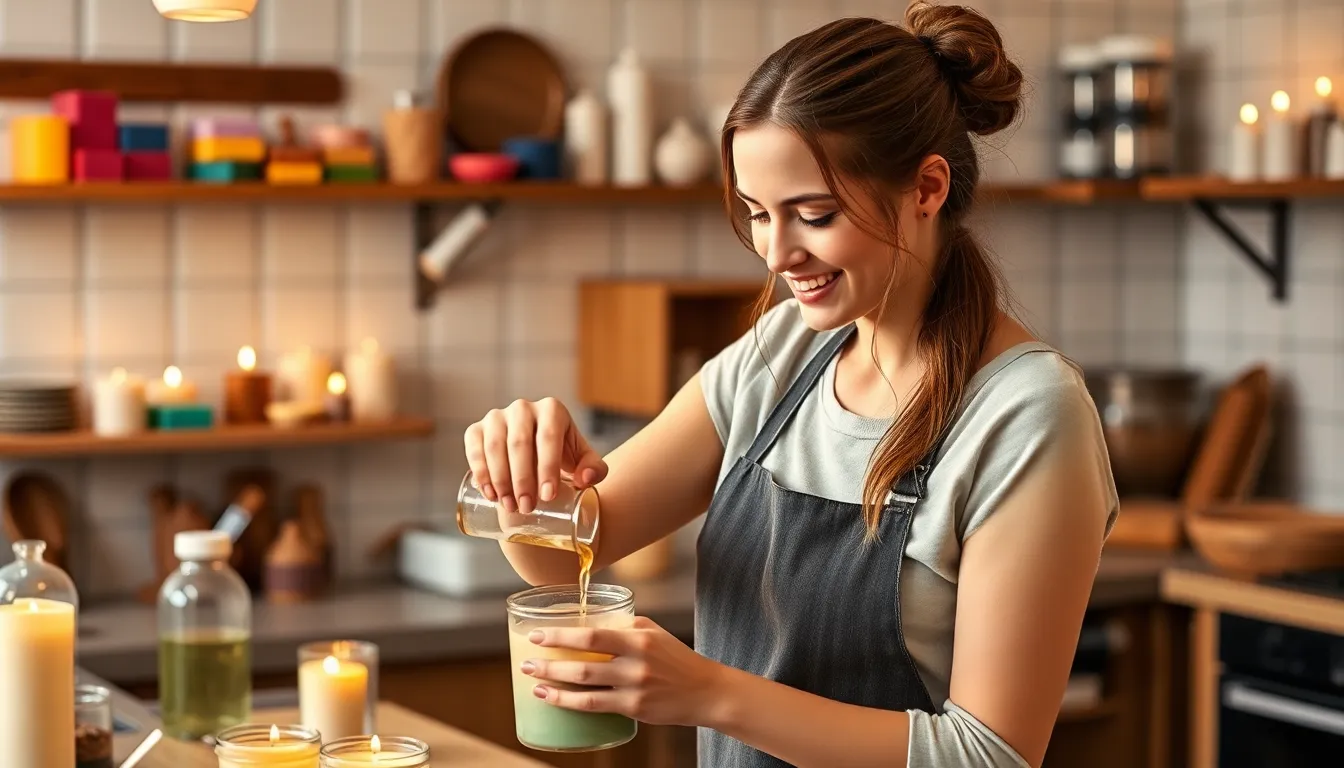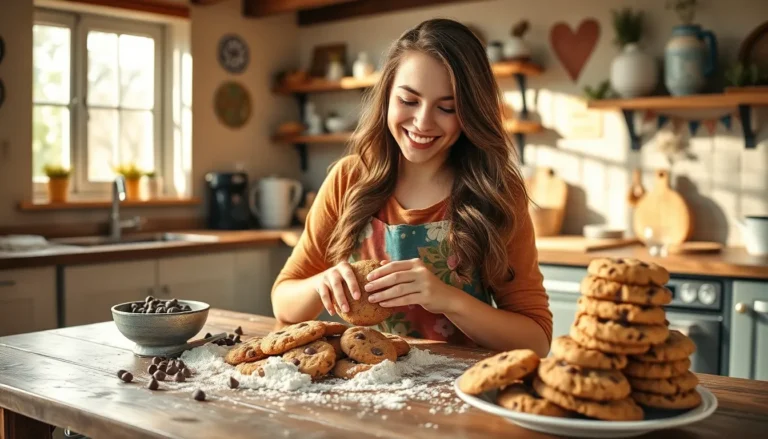Table of Contents
ToggleImagine walking into a room filled with the warm glow of flickering candlelight and the delightful aroma of your favorite scent wafting through the air. Making candles isn’t just a hobby; it’s a chance to unleash creativity while crafting the perfect ambiance for any occasion. Plus, who wouldn’t want to impress friends with handcrafted masterpieces that smell as good as they look?
Benefits of Making Candles
Making candles offers numerous advantages, appealing to both physical and emotional wellbeing. Crafting candles serves as a fulfilling and enjoyable hobby.
Relaxation and Stress Relief
Creating candles provides a soothing outlet after a hectic day. Engaging with wax and scents encourages mindfulness, redirecting focus from stressors. Many find the rhythmic melting and pouring motions calming. The act of choosing fragrances can uplift spirits, allowing personal preference to shine. Aromatherapy effects from essential oils promote relaxation, enhancing overall mental health. Individuals often describe a sense of peace that comes from candle-making sessions. Incorporating this hobby into a routine can lead to improved mood and decreased anxiety levels.
Creativity and Personal Expression
Making candles taps into creative instincts, offering a canvas for personal expression. Various colors, shapes, and scents can be mixed to reflect unique personalities. Experimenting with different combinations fosters innovation and artistic exploration. Individuals can craft custom candles for special occasions or as gifts, adding a personal touch to celebrations. Designing labels and packaging further enhances the creative process, showcasing individual flair. Each candle becomes a reflection of taste and style, celebrating individuality. This creative endeavor not only results in beautiful products but also boosts confidence in artistic abilities.
Materials Needed to Make Candles

Making candles requires specific materials to ensure the process is smooth and enjoyable. Understanding the necessary components helps in selecting the right items for crafting quality candles.
Types of Wax
Soy wax burns cleanly and is eco-friendly, making it a popular choice among crafters. Paraffin wax, derived from petroleum, holds fragrance well and offers a bright, strong burn. Beeswax, known for its natural qualities, has a sweet aroma and emits negative ions, cleaning the air. Palm wax provides a unique, crystalline finish and is biodegradable, appealing to environmentally conscious individuals. Each wax type affects scent throw, burn time, and the overall appearance of the finished candle.
Wick Selection
Choosing the right wick is crucial for proper burning and scent throw. Cotton wicks are often used for their clean burn and affordability; they work well with various waxes. Wood wicks create a warm ambiance, producing a crackling sound reminiscent of a fireplace. Hemp wicks, known for their durability, burn evenly and provide a modern twist to candle making. Wick size should correspond to the candle’s diameter to ensure adequate melt pool and prevent tunneling, enhancing the overall experience.
Step-by-Step Guide to Make Candles
Candle making requires attention to detail and a few essential steps for success. This guide outlines the process, ensuring enjoyable crafting experiences.
Preparing Your Workspace
Creating an organized workspace is vital for candle making. Gather all materials before starting. Ensure a flat, stable surface protects it from spills or heat. Use newspaper or paper towels to catch wax drips. Adequate ventilation promotes safety and comfort during the process. Various tools, like a double boiler, thermometer, and pouring pitcher, should be accessible. Having a clean workspace enhances focus and minimizes distractions for better results.
Melting the Wax
Melting wax occurs in a double boiler or microwave. Choose a vessel safe for heat exposure. Heat the wax gradually to prevent scorching, ideally between 170°F and 180°F. Measure the wax based on container size, aiming for a recommended 1 pound per 16 ounces of container volume. Stir occasionally for an even melt. Consistent monitoring ensures proper temperature and texture, key factors for a smooth pour.
Adding Scents and Colors
Selecting scents and colors elevates the candle-making experience. Essential oils or fragrance oils can infuse enticing scents, typically using 1 ounce per pound of wax. Color dyes, in liquid or chip form, enhance visual appeal. Experimenting with combinations often yields unique results. Mix colors and scents while wax remains melted for a seamless blend, capturing the desired ambiance and personality unique to each creation.
Pouring and Finishing
Pouring wax into containers requires careful handling for optimal results. Allow the melted wax to cool slightly before pouring, aiming for about 160°F. Fill each container to the desired level while securing the wick in place. Allow sufficient time for candles to harden completely, often between 4 to 24 hours. Trim wicks to approximately ¼ inch once the candles cool, ensuring a clean, even burn. Create elegant finishes by decorating containers with labels or embellishments that reflect personal style.
Tips for Successful Candle Making
Successful candle making requires attention to detail and an understanding of common pitfalls. Following guidelines helps in creating beautiful and functional candles.
Common Mistakes to Avoid
Avoid overfilling your containers, as this can lead to messy spills. Skipping wick testing may cause uneven burning or poor scent throw. Not measuring fragrance oils precisely results in weak scents or overpowering aromas. Disregarding the temperature when pouring wax impacts the final product’s appearance and consistency. Ignoring safety protocols, like wearing gloves, can lead to accidents during the process. Recognizing these mistakes enhances the candle-making experience and improves results.
Safety Precautions
Prioritize safety by working in a well-ventilated area. Use heat-resistant containers to prevent accidents. Always wear protective gear, including gloves and goggles, to shield against burns. Measure wax and fragrance oils carefully to avoid spills and reactions. Keep flammable materials away from the workspace to ensure a safe environment. Additionally, have a fire extinguisher nearby for emergencies. Following these precautions creates a safe and enjoyable candle-making experience.
Candle making offers a fulfilling blend of creativity and relaxation. By engaging in this hands-on craft, individuals can create beautiful pieces that reflect their personal style while enjoying the therapeutic benefits of the process. The joy of selecting scents and colors transforms each candle into a unique expression of taste.
With the right materials and techniques, anyone can embark on this rewarding journey. Whether for personal use or as thoughtful gifts, handcrafted candles bring warmth and light into any space. Embracing this hobby not only enhances one’s environment but also fosters a sense of accomplishment and creativity. So why not light up your life with the art of candle making?




